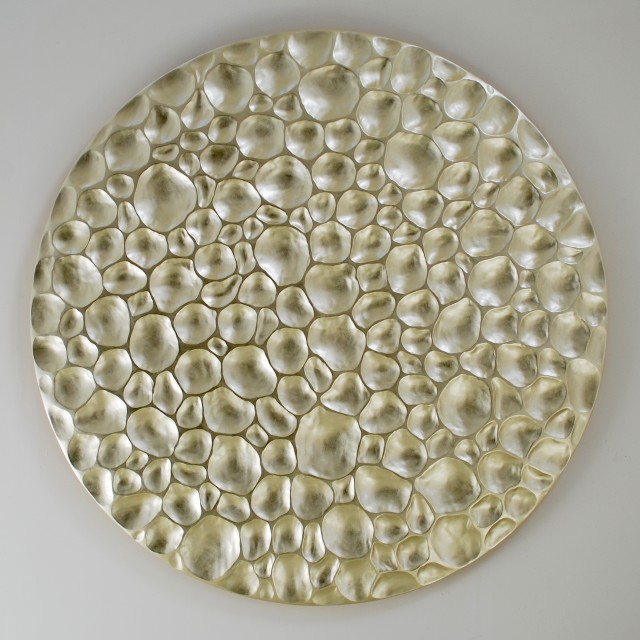|
Catalogue introduction to LUMINA exhibition by Joseph Clarke, Gallery Director
|
|||
|
The main goal of the alchemists was to produce gold from other base substances. Their symbol for gold was the circle with a point at its centre, this was also the astrological symbol and the ancient Chinese character for the Sun.
Many of the works in this exhibition are based around the circle - it is a shape that has specific resonance for all of us. In early science, particularly in the fields of geometry, astrology and astronomy, the circle was connected to the divine for most medieval scholars, and many believed that there was something intrinsically sacred or perfect that could be found within the form. It offers a sense of completeness and demands observance. Allen describes looking at these dynamically carved wooden circular forms as being like 'looking through a lens and focussing on a small part of an implied greater whole'. The rhythms or cells within the circle can within the minds eye be read to fill a greater space beyond that lens or be part of a far greater orbit. As forms we could limit them and imply that they explore the microcosmic and / or the macrocosmic. In fact the works in 'Lumina' are far more abstract in focus and intent, which is for me a particular area of growth and potential. These things do not depict 'something'; indeed they remain open ended to the point that we can meditate 'everything'. They become about the relationship, connection or interconnection of all things. A meeting place for light and matter, the past and the present. The work questions its physical boundaries extending beyond to a more metaphysical space. Allen has also produced a series of vibrantly coloured works on paper and pigmented sculpture. The colour is built up through a series of painted and splattered layers of pure pigment. The works on paper are exploratory and ambiguous, often re-worked where new images are found through a process of subtraction and removal, using a method, which could be described, as 'un-painting'. If viewed literally they are suggestive of nebula or microscopic cellular organisms - for me their reason is once again more open-ended. Unlike the wall of colour offered by Rothko these are portals that draw us in and through. It is however the gilded surface that Allen is synonymous with. Gold has always been a debated material, which has for a large part of human history adopted many different significances. We (us living in the contemporary western world) are used to economic contexts where gold is noted for its inherent material value, and a social context where it is an indicator of status and position. Importantly and relevantly there are also religious contexts where it is used to express reverence of divinity and magical contexts where the perception is a material with inherent powerful qualities. In many religions, through modern and ancient interpretation, the luminescence and energy of gold, its indestructible yet malleable properties and its relative scarcity made it the perfect material to embody qualities of divinity. Throughout religious history, gold was perceived as an appropriate material with which to address and convey the glory of the deity. Temples, sanctuaries and churches were decorated lavishly with gilded statues and images or pattern. There is also a long convention of golden votive offerings. Reliquaries, crosses and objects needed for sacred ritual were often made of gold. Such objects tend to be interpreted in archaeological research as having religious or magical properties, often appearing in locations suggestive of some form of ritual performances or ritual deposition. Common to both, religious or magical, was the belief that it was possible to connect with another world through material objects and rituals associated with them. In the case of religion to bow at the feet of greater forces and energies, in the case of magic to attempt to harness those forces or energies for ones own goal. Because of the value that we as humans have placed upon it, we can define the symbolic nature of gold as a perennial method of transmission applied firstly in different situations from one person to another but also, secondly, between humans and a spiritual world. As a contemporary artist working within the contemporary art world - where we are used to measuring these factors from the point of view of their economic and social contexts - the use of this material is understood to be loaded and misleading. The truth of Allen's work lies in the examination of these other contexts - in spiritual and magical properties. These are far greater indicators as to why Allen continues to use this material, in fact why no other material can be used to make the statements that he is looking to make. For me Allen's use of this material is both magical and spiritual - he is in both reverie and control, creating works that hint at the greater micro and macro forces and energies of our existence - the physical and the transcendental. Unlike Hirst cladding the skull in Diamonds. The ancient properties of gold are not there to mask and guard the inevitable truth within. In the case of Hirst - that we are all mortal, that there is an inevitable end. With Allen, gold is a gateway, and the light that is reflected is ever present, this message does not speak of the end - it speaks of the infinite, of forces greater than ourselves, but forces that we can claim to be a part of, and to be a part of us. |
|||
Lumina
May 17, 2013
